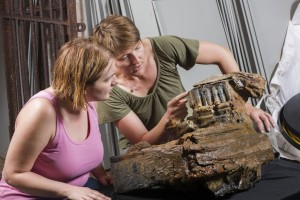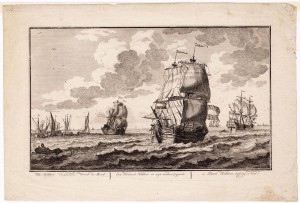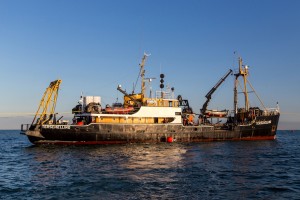New evidence from the wreck of the Dutch East India Company (VOC) ship Rooswijk, off the Kent coast, tells a tale of smuggling and reveals who was on board, during major shipwreck excavation
- Dives start in Kent as excavation of the protected wreck site of the Rooswijk by Dutch and British maritime archaeologists continues
- Recent discovery of silver coins with small holes deliberately made in them suggests they were sewn into the clothes of the crew to smuggle to the Dutch East Indies
- Researchers have identified 19 of the Rooswijk’s crew from documents held in Amsterdam archives
Maritime archaeologists diving the site of the shipwreck on the Goodwin Sands, continuing excavations started last summer, are revealing more of life on a Dutch East Indiaman from the 18th century; the Rooswijk sank in January 1740 with all 237 crew lost. It seems that many of the Dutch and Scandinavian crew adopted an entrepreneurial approach to their voyaging and stitched silver coins into their clothing for their “personal trade”, which was against company rules at the time. The finds suggest that half of all the silver aboard the ship was contraband.

Angela Middleton (conservator Historic England) and Sara Bohuch (student conservation at University of Cardiff) are looking at the thimble chest that was recovered from the Rooswijk site. Copyright Historic England/Cultural Heritage Agency of the Netherlands
The ship set off on her last journey, from the Netherlands to Batavia (modern-day Jakarta), with a lot of silver on board – all of it destined for trade in Asia. The precious metal was in high demand and was exchanged for spices and porcelain. The value of the Rooswijk’s known cargo is thought to have been more than 300,000 guilders, mostly in the form of silver ingots and ‘pieces of eight’ – Mexican reals – these were minted to a recognised standard weight, making them perfect for international trade.
However, archaeologists have uncovered lots of other, older coins at the wreck site including ducatons from the Republic and the Southern Netherlands (now Belgium) that were not part of the sanctioned cargo. This points to the Rooswijk’s passengers and crew carrying extra silver to trade illegally. Other coins found during the dives have small holes deliberately made in them, an indication that the crew sewed them into their clothes to smuggle to the Dutch East Indies. Concealing the coins in this way also kept them safely hidden from others on board. It’s also known that people were smuggling silver in their shoes and belts, such was the demand overseas.
Smuggling silver was officially prohibited by the Dutch East India Company (VOC) although it seems to have been common practice by many VOC personnel. It’s thought that by the time the Rooswijk went down, up to half of the money being transported on these ships was illegal. It has been estimated that a total of 20 to 40 million ducatons were illegally shipped to Asia in the 17th and 18th centuries.
Martijn Manders, project leader of #Rooswijk1740, said: “The Rooswijk is special because it tells us about ordinary people of that time, but also about entrepreneurship, and (trade) relationships that ensured connections between cultures all over the world. We consider this to be shared cultural heritage. We therefore work closely with our counterpart Historic England.
“Our British colleagues are now mainly working on the conservation of the finds in Portsmouth, which is a very important part of the project. The finds help us tell the story of the people on board, we can relate specific personal objects to what they did in general: how they lived, what the circumstances were on board the ship.”

A drawing of a ship similar to the Rooswijk – a Dutch ‘hekboot’ by Adolf van der Laan in 1716. (Copyright) Collection of the Fries Scheepvaartmuseum.
Duncan Wilson, Chief Executive of Historic England, said: “It’s extraordinary that after more than 270 years we now know the names of some of the people who may have lost their lives with the Rooswijk. Sea-faring was a dangerous way of life and this really brings it home. The revelation that the Rooswijk was used to smuggle silver adds to our understanding of global trade at this time – we shall have to wait and see what else we might discover from this site in the coming months.”
As a protected wreck site the Rooswijk’s remains are owned by the Dutch Government, and managed by Historic England on behalf of the Department for Digital, Culture, Media and Sport. The #Rooswijk1740 project is led by the Cultural Heritage Agency of the Netherlands, in collaboration with Historic England and contractor MSDS Marine.
Crew members identified
Researchers in the Netherlands have also been able to postively identify and name 19 of the 237 members of the Rooswijk’s crew from documents held in Amsterdam archives. Until now it was only clear that the Rooswijk was under the authority of skipper Daniël Ronzieres, as all other records of the crew and passengers were lost in the shipwreck. Two tibia (leg bones) from two individuals have been recovered from the wreck and there is potential for more human remains to be found.
Dutch genealogists carried out new archive-based research and have been able to identify several more crew members for the first time, and a little more about their lives before tragedy struck. Those identified include a senior surgeon who travelled to the East and back several times (Gerrit Hendrik Huffelman), a 19-year-old on his first VOC voyage (Thomas Huijdekoper) and a sailor who had previously survived a shipwreck (The Westerwijk) at the Cape of Good Hope (Pieter Calmer). We know that the men on board the Rooswijk were born in the Netherlands as well as some coming from German, Swedish and Norwegian backgrounds.
Several crew members of the Rooswijk have been identified thanks to transport letters in the Amsterdam City Archives. Transport letters authorised someone to collect a part of a crew member’s salary from the VOC. It is known that VOC personnel used these letters because of a lack of cash or credit – they used them to pay for accommodation, buy supplies for the trip to Asia or exchange them for cash.
Other indivduals were found because they visited a civil-law notary before setting sail, for example to draft a will. These deeds contain the name of the ship on which the voyage was to take place, linking person and place.
The Rooswijk was built in 1737 in Amsterdam, for the Chamber of Amsterdam of the Dutch East India Company (VOC). On the 8th of January 1740, the Rooswijk set sail for its second voyage and foundered on the Goodwin Sands. There were no survivors. The cargo consisted of a large amount of both silver ingots and coinage, together with cut stone blocks and iron bars.
The site was originally found by a sports diver. In December 2005 the wreck site was partly excavated and the finds handed over to the Netherlands Finance Minister, representing the Dutch Government as heirs to the Dutch East India Company.
There are a total of 250 Dutch East India Company shipwrecks, of which only a third have been located. Never before has a Dutch East India Company wreck been scientifically researched or excavated on this scale.
From Historic England and the Cultural Heritage Agency of the Netherlands



